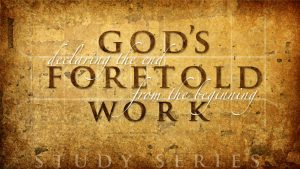Dear Reggie,
As we seek to understand the prophecy in Daniel regarding the career of Antichrist and where it begins, I continue to get questions about the transition between Ch. 11:21 and 23 and why we are not giving any of this to fulfillment by Antiochus IV Epiphanes. We speak of him as a foreshadow and type of Antichrist but nothing much more. Antiochus did invade the Holy Land and Jerusalem. He did stop the sacrifice and perform abominations with unholy and blasphemous offerings. The saints were given into his hand for approximately 3 ½ years. He was defeated and the Temple worship and sacrifices were restored. The Temple was rededicated [Ch 8:14]. Jesus attended the feast of rededication. Jews celebrate the feast of Hanukkah.
Question: In our quest to be fully accurate in “apocalyptic evangelism” especially to the Jewish community, where exactly do we fit the career of Antiochus into this picture as it intermingles with and then becomes the career of Antichrist? I believe it will be very important to be clear on this as we move closer to it’s fulfillment.
I feel that when we “give” any of that section to Antiochus (as anything more than a typical and partial fulfillment), we will not be able to get it back. It is the same thing with the Olivet Discourse. Let me explain by example: Many see a part of the Olivet Prophecy, as divided between 70 A.D. and the consummation, as though only a small balance remains for future fulfillment, with no clear distinction as to which is which, what is past and what remains. There is much disagreement on “which part”, or exactly how much was fulfilled. I find the same problem here. Where’s the gap?
One thing’s for sure: Whoever stands up in the estate of the king of the north (if antiquity, this is Antiochus lll), whether Antiochus lV Epiphanes, or a final Antichrist, that one continues to the end, i.e., the resurrection of the dead and the deliverance of Israel (Dan 12:1-2). No gap is apparent and clear anywhere in Dan 11, but the conservative believer must find it somewhere. So why not somewhere between Dan 11:21-45? Some futurists propose the gap between verses 35 and 36. I believe I can show how untenable this is from a strictly exegetical standpoint. In my view, it gives away the farm.
Certainly there is overlap of type and anti-type, but it will not do to say that Antiochus fulfills the prophecy down to a certain verse, and then breaks off, leaving a gap in the narrative (who knows where?) to be picked up and carried through to the end. In my view, the type fades ‘mysteriously’ into anti-type, but the future fulfillment doesn’t merely take up where the type left off. Rather, it takes up, not where the type left off, but where the type began. Only this time, the prophecy follows all the way through to the end with utmost continuity of literal detail. That’s my view. I’ve just got to prove it.
Jesus well knew that the book of Maccabees regarded Antiochus to be the one who placed the abomination, but He disregarded this popular view in deference to an infallibly inspired scripture that requires full attention to every jot and tittle of literal detail. So it was clear to our Lord, even from the standpoint of His perfect humanity, that the end did not follow 1290 “days” (nor years) after Antiochus’ desecration of the holy place. I’m jealous for this, not only for sound exegesis, or an apologetics interest in discussing this with Jews, but for a very practical purpose that is eminently spiritual in its result.
Here it is: To the degree that the events of Dan 11:23-30 are lost to us (by finding them sufficiently accounted for in antiquity), then to that degree the church is robbed of the kind of specific signal events that constitute a march, or countdown of events that I believe are ordained to straighten and prepare the godly remnant for the time of great transition in the middle of the week, and the tribulation that follows. Not only this, but it negotiates away very important theological leverage, when we lose the important references of a Jewish Jerusalem to what is called, “the holy covenant” (Dan 11:28, 30).
I can’t go into it now, but the question of whether the term, “holy covenant”, belongs to antiquity or the future, is decisive theological leverage against all forms of replacement theology. One would have to know something of the very involved Daniel scholarship, both liberal and conservative, to fully appreciate how decisive this is for the church. I believe there is sufficient evidence to pluck this back from the liberals and amills, and even the dispensationalists, who make the break between antiquity and eschatology, not between Dan 11:20-21, but between 35-36.
Furthermore, it reflects on the Islamic hatred of the “holy covenant” that entails a Jewish temple, either in place of, or perhaps beside, “the Noble Sanctuary” , requiring the moving of some major political mountains. It also robs of strategic perspective to recognize the Arab / Islamic connection to the Jerusalem question, which dramatically impacts how the end is viewed, as per the nature and origin of Antichrist, the ten nation confederacy, and the controversy of Zion. So a great deal hangs on this, whether directly or indirectly. You get my point.
Finally and foremost, it is important that we see that we are searching out a divinely ordained mystery, with sufficient evidence from scripture for the believing heart, but with plenty built right in that is calculated to elude the pride that is in the academic world. Yes, I believe God built into His very Word, in a holy and honest way, a mystery designed to stumble pride. Mere exegetical skill will not take the place of the Holy Spirit when we approach a God of this kind.
These be the days, Reggie




